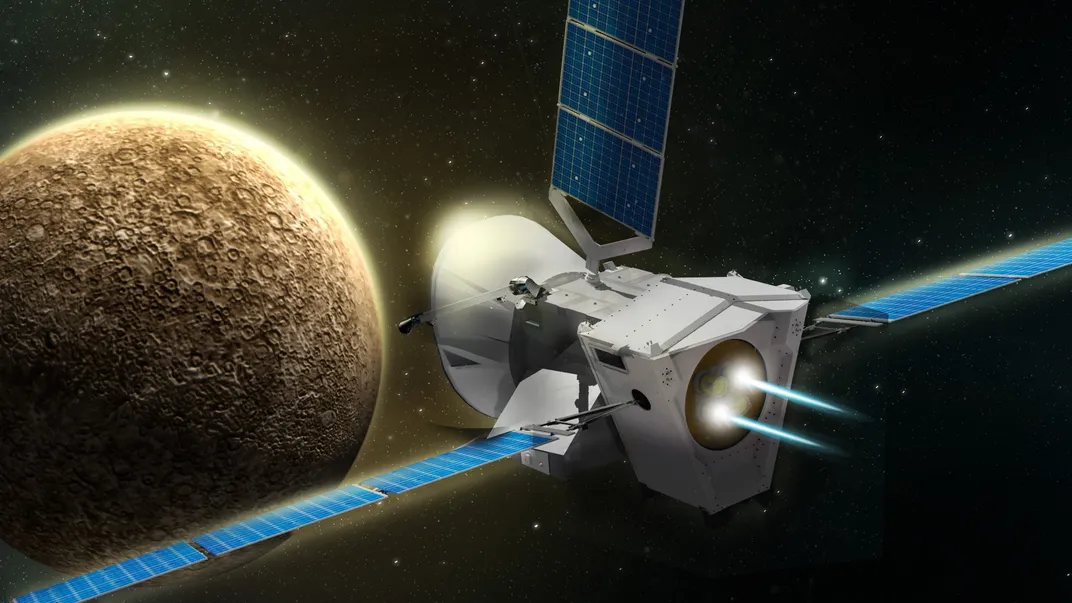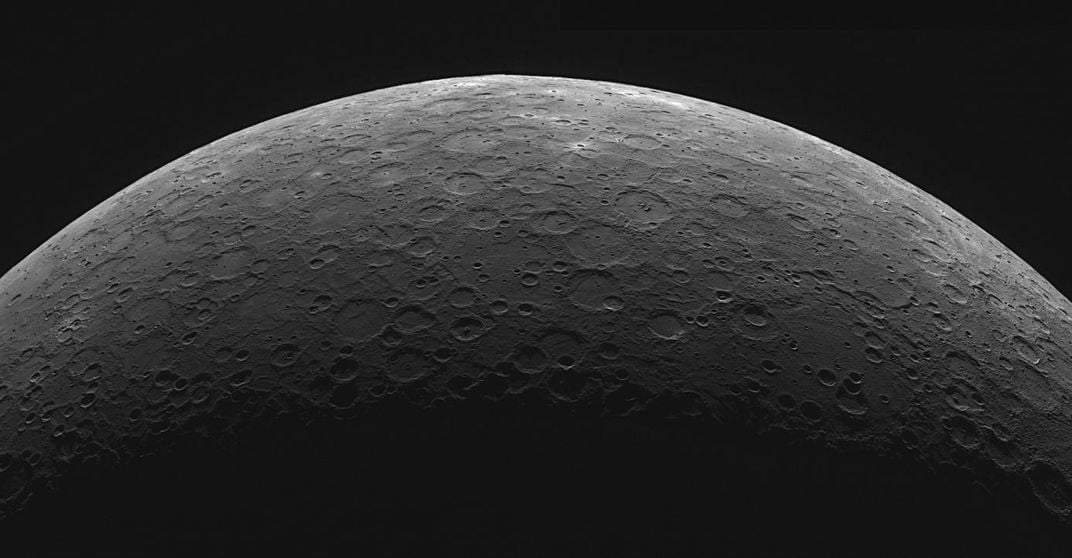Spacecraft Launching This Week Will Explore the Mysteries of Mercury
The BepiColombo mission will study the geology and magnetism of the smallest planet to search for clues of our solar system’s beginnings
/https://tf-cmsv2-smithsonianmag-media.s3.amazonaws.com/filer/a9/20/a920e5f2-be10-4239-a2f9-2abd846485a4/pia16853_modest.jpg)
In the 19th century, the orbit of Mercury began to fluster the world’s astronomers. The planet’s path around the sun rotated, or precessed, at a rate that could not be explained using Newton’s theories of gravity. Many scientists came to believe a smaller, undiscovered inner planet was perturbing Mercury. But after 1916, when Albert Einstein published his theory of general relativity, astronomers realized the enormous mass of the sun warped the fabric of spacetime, sending nearby Mercury on a tumbling path around our star.
To this day, Mercury continues to befuddle planetary scientists. The hot little world remains the least-explored rocky planet in the solar system, although not for much longer. A joint mission from the European Space Agency (ESA) and the Japanese Aerospace Exploration Agency (JAXA) will launch two spacecraft to Mercury together, slated to lift off from ESA’s spaceport outside Kourou, French Guiana, on Friday, October 19.
The two craft are collectively known as BepiColombo, named for Italian scientist and mathematician Giuseppe "Bepi" Colombo who proposed the first interplanetary gravity assist maneuver in the 1970s. The BepiColombo spacecraft will measure the composition and magnetic field of Mercury, attempt to learn about the formation of the planet’s large core, search for signs of volcanism among the craters and valleys—and more than a century after the fact, measure the orbit of Mercury to test Einstein’s relativity with more precision than ever before.
“Our goal is to characterize the planet as best as we can,” says BepiColombo project scientist Johannes Benkhoff of ESA. “We want to learn many things because of its role in the formation of our solar system. We believe that Mercury is a very important piece of the puzzle.”
The BepiColombo mission will take approximately seven years to arrive at Mercury. Traveling to the very inner solar system is actually much trickier than sending a spacecraft to the outer realms, and the craft will need to make good use of the gravity assists that Giuseppe Colombo is known for. More than a year after launch, BepiColombo will swing by Earth to get pushed inward, fly by Venus twice and swoop over Mercury six times in a complex orbital dance that will allow it to enter orbit around the planet in late 2025. Upon arrival, ESA’s Mercury Planetary Orbiter (MPO) and JAXA’s Mercury Magnetospheric Orbiter (MMO) will separate from the mounted solar panels and ion thrusters that brought them there, the Mercury Transfer Module (MTM).

BepiColombo will build on the work of the only other spacecraft to orbit Mercury, NASA’s MESSENGER probe. That mission revealed a world that looks a bit like our moon, crater-pocked and barren with deposits of water ice near the poles. But unlike the moon, Mercury is hot as an oven, geologically active, and has large sulfur deposits that dot the rocky landscape.
The sulfur presents an interesting mystery, Benkhoff says, as the lighter material should have been blown away by the solar wind. These unexplained sulfur drifts hint at volcanic processes below the surface, which could produce sulfur gasses like on Earth.
The unique tectonic activity of Mercury is another sign of a dynamic world. Unlike Earth’s many plates that shift and rub together, Mercury has just one plate surrounding the planet. As a result, the little world contracts, causing deep cracks and chasms to open on the surface. These contractions occur as Mercury cools, though why the planet is cooling is a hotly debated question in the planetary science community. Mercury has been cooling down for billions of years, a process that continues today, but this venting of heat was expected to have slowed after the planet formed.
“Mercury has this array of faults that really pretty clearly show that the planet has contracted over some period of time,” says Tom Watters, senior scientist in the Smithsonian Center for Earth and Planetary Studies and a MESSENGER team member. “One of the most fascinating things to me is that here's a planet, much smaller than the Earth, the smallest in the solar system, that is showing us how a smaller body will express its contraction without the benefit of plate tectonics.”
Underneath the shriveling outer crust of rock, Mercury’s liquid metal core is thought to be massive, with a possible solid core at the center. Scientists estimate that 70 to 80 percent of Mercury is made up of its core, making it the second densest planet in the solar system after Earth. And such a large metallic composition gives Mercury another notable feature: a strong magnetic field.
“The discovery of the magnetic field in the 1970’s was totally unexpected,” Benkhoff says.
While Europe’s MPO orbits close to the surface to study the geology of Mercury, Japan’s MMO will loop farther out to study the planet’s magnetic field. Though the planet is only one third the size of Earth, Mercury has a similar magnetic field. For years, scientists have wondered if the planet's internal workings drive the magnetism or if it is due to interactions with the nearby sun.
The connection between the sulfur on the surface, the cracking and cooling of the crust, and the active magnetic field provides hints of Mercury's formation. Many objects in the solar system didn’t always live in their current locations, forming farther out and migrating inward, and Mercury could be one of these objects. Whether nudged in by other planets or always confined to the immediate vicinity of the sun, the history of Mercury is considered critical to understand if astronomers are ever to learn how our solar system came to be.
But whatever happened to Mercury in the past, the planet still presents some strange questions today. If it’s active, with sifting sulfur and watery ice, could anything biological be on the surface?
“On one hand you have temperatures of 450 degrees F like a pizza oven,” Benkhoff says. “Then you have water ice in the craters; this is fascinating. Imagine if we were the first to find biological markers in these craters. While all the other people are looking on Mars and [Jupiter’s moon] Europa, maybe it’s on Mercury!”
After over a decade of waiting, ESA and JAXA are poised to begin their long journey to Mercury. This weekend, BepiColombo embarks on a quest to better understand not just one of the most enigmatic planets, but how our little neighborhood in space came together billions of years ago.


